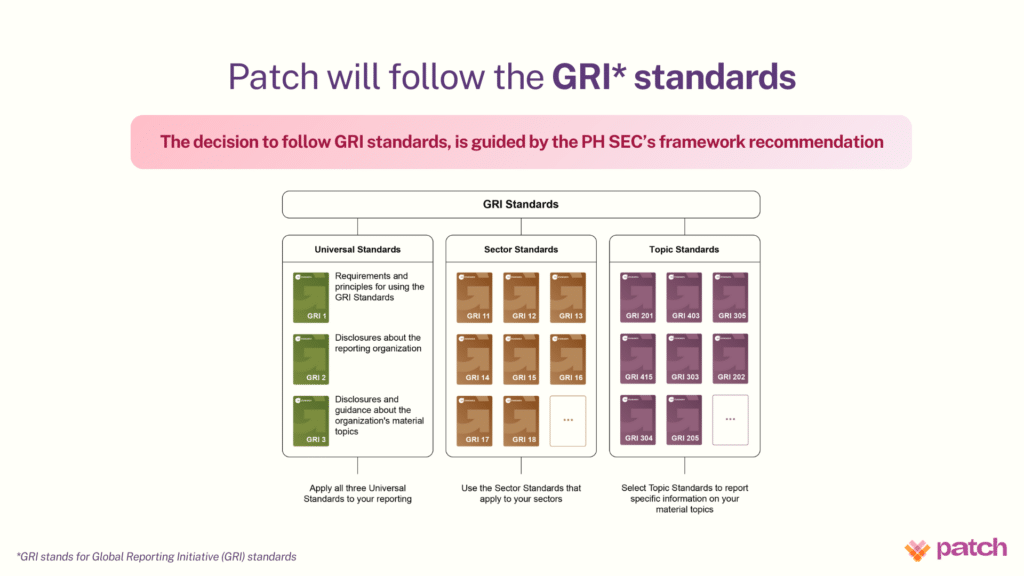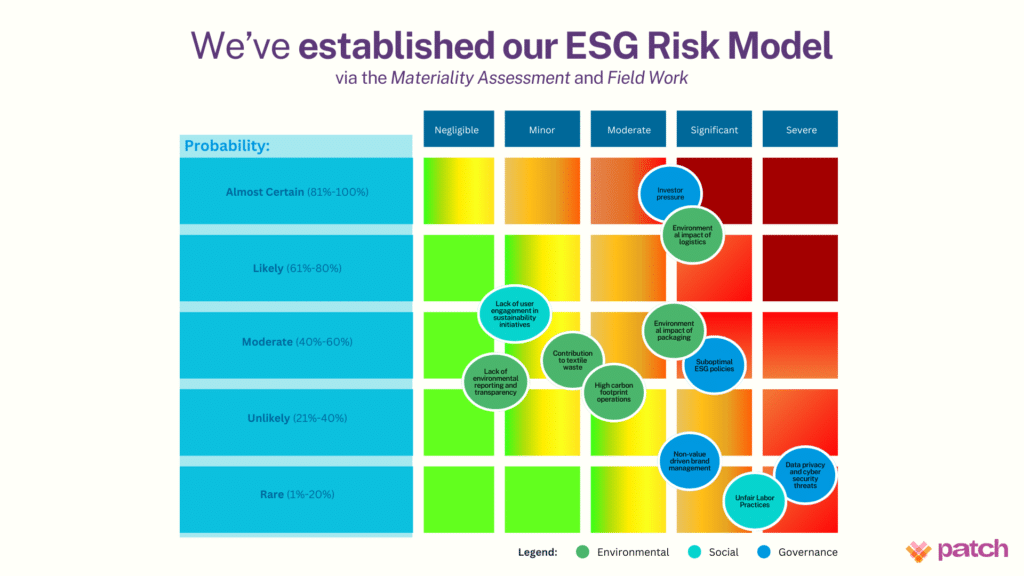SOCIAL IMPACT ACCELERATION
Kindly review our video pitch below:
| Figure 1. Video pitch for social impact acceleration. |
If the uploaded video isn’t working, kindly proceed to this youtube link: https://youtu.be/xBWv0R9EfnQ.
To check the full documentation from our fieldwork, click this link: https://drive.google.com/drive/folders/1J5XeZlYnrht49y7n5JKsOmXaJCkHMDVj?usp=drive_link.
Some of our documents are confidential and uploaded onto the CONFIDENTIAL INFO page.
A. Social business description
A1. Social mantra one-liner: Empowering sellers and bringing clothing back into circularity through a peer-to-peer marketplace for AI-assisted thrifting.
Patch (see projectpatch.co) is a SaaS-enabled circular fashion marketplace for seamless peer-to-peer online thrifting. We offer an end-to-end solution for buying and selling thrifted and handmade clothes, using smart image recognition to automatically organize listings and an escrow system to ensure secure payment and shipping.
In round 3, our one liner was “Patch is a circular fashion marketplace for trustworthy and AI-assisted thrifting”. Through calls and onsite conversations, we learned that both our buyers and sellers found the AI features attractive. At the same time, both segments expressed their concerns on our promise of delivering trustworthiness.
For round 4, we tried testing again a new one-liner which is “Empowering sellers and bringing clothing back into circularity through a peer-to-peer AI-assisted fashion marketplace” since this properly communicated our intended impact (empowering sellers…circularity) through our value proposition (peer-to-peer marketplace…thrifting). We wanted to gather more feedback and expand our communication channels compared to the previous round.
Through our social media, we were able to do a poll to get our stakeholders’ opinion on the branding of Patch through our one-liner. We asked how our new one-liner resonates with them compared to the previous one-liner and found that expounding what Patch does in the one-liner helps communicate our goal.
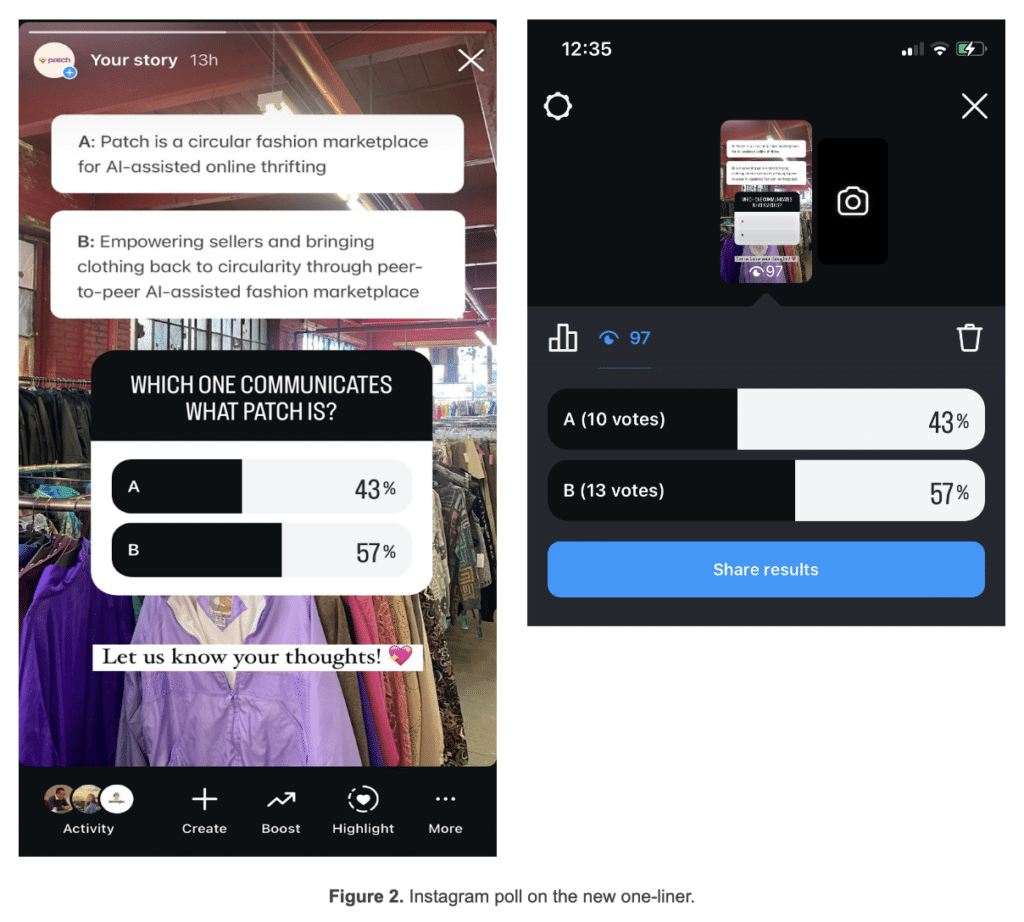
We were also able to set up a call with some people who were engaged in the thrifting scene. Many mentioned that saying “AI-assisted thrifting” in the one-liner paints a clearer picture of what Patch offers and also piques the curiosity of some people on how we will deliver our services. The following conversations can be played through these audio recordings: A1_audiorecord1_link, A1_audiorecord2_link.
A2. Social impact clarity and significance
Our vision is to make circular fashion easily accessible to Filipinos, with plans to expand across Southeast Asia. We want to streamline the thrifting experience using AI and automation, and encourage Filipinos to participate in the circular economy through the simple act of buying and selling clothes which is the most accessible asset people own. Ultimately, our goals are twofold:
- To reduce labor-intensive practices for sellers, doubling their income, and decreasing setup time by threefold, while providing buyers with a secure, streamlined shopping experience that offers high-quality thrifted finds.

- To promote sustainability through increased circulation of recycled and upcycled garments, with the goal of bringing 1 billion clothing items back into circularity by 2030.

Patch captures value by automating inventory and transaction processes, enhancing user experiences, fostering a community of eco-conscious consumers, and generating revenue and achieving financial stability to ensure that our growth directly amplifies our positive impact. Currently, we have identified 6 revenue streams to activate within the next 3 years, projecting gross revenue of USD 40,000 by the end of Year 1, USD 260,000 by Year 2, and USD 735,000 by Year 3, with break-even anticipated in Year 3 (see our Financial Projection sheet in CONFIDENTIAL INFO for reference).

Patch differentiates itself through its automated workflows for both sellers and buyers who want to shop secondhand seamlessly and securely. Unlike a traditional e-commerce platform, being SaaS-enabled means that Patch can offer sellers tools that would make their jobs easier and provide the buyers with information that can assist them in responsible consumption. Aside from automation, our platform also extends to others via cross-posting capabilities, allowing sellers to maintain multiple sources of revenue with just one app. Patch is also developing our proprietary multi-bidding model that is optimized for the Southeast Asian thrifting markets as informed by our fieldworks during the last few months of our participation in the Social Business Creation competition.

Our hybrid business model combines SaaS and e-commerce/peer-to-peer marketplace functionalities, securing recurring revenue through our seller tools while capturing high-frequency and high-volume user engagement via traditional marketplace activities.
To ensure that our narrative emotionally connects with our audience, we’ve conducted extensive fieldwork and gathered insights directly from our community through Instagram. We found that most of our intended users thrift due to the added economic and social value. They thrift to style and enter the fashion market while being cost-efficient. Some also thrift because they want to find rare, vintage, and stylish pieces.

We were also able to have one-on-one conversations and their reasons for entering the thrift market also resonates with the response we got from the polls. They thrift because it’s cost-saving and they can find unique pieces that’s not often sold in malls. Some also become aware of the environmental impact of thrifting and stated that buying a piece of cloth through a sustainable practice gives them the feeling of contributing to the efforts of displacing waste. The following recording can be played through this: A2_audiorecord1_link, A2_audiorecord2_link
There have been calls for sustainable consumption and ethical clothing. Eco-conscious choices are being highlighted to increase consumers to switch to a greener wardrobe. One of the leading advocates for sustainable fashion is Basically Borrowed (@basicallyborrowed on Instagram). They host workshops and talks to educate consumers on the current state of sustainable fashion, and encourage them to switch to a greener wardrobe. They are continuously hosting events that show how people are becoming more interested in thrifting. Patch saw this as an opportunity to capture the growing market of campaigns in sustainable fashion by providing an avenue for the stakeholders to fast track their reach and eventually subtly shifting consumers to a more convenient and safe thrifting.
Patch also aligns itself with several UN Sustainable Development Goals (SDGs), specifically Targets 8.2, 8.3, 9.1, 12.5, and 12.a.
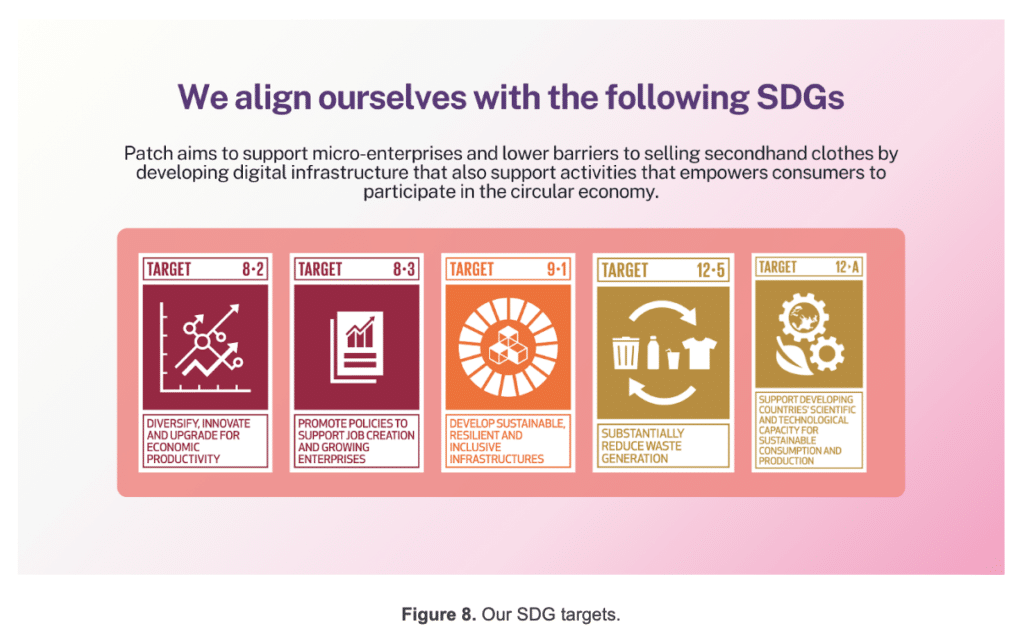
Patch aligns itself directly to these targets as witnessed from our economic and social value, and our way of capturing these values.
- Target 8.2: Patch wants to facilitate higher levels of economic productivity by leveraging AI and automation to streamline the selling process of secondhand clothes.
- Target 8:3: Our platform provides tools that support the growth of micro-enterprises by enhancing their productivity, lowering the barriers to entry in selling secondhand clothes, and encouraging the formalization of thrift stores in the Philippines (and Southeast Asia).
- Target 9.1: We are developing a reliable, sustainable, and resilient digital infrastructure that is designed with equitable access in mind.
- Target 12.5: We directly contribute to reducing waste generation with our goal of bringing 1 billion clothing items back into circularity by 2030.
- Target 12.a: We are building a digital infrastructure that is strengthening the capacity of consumers to participate in the circular economy.
Our impact measurement will be mapped to these SDG targets, focusing on the volume of clothing items recirculated, the income uplift for sellers, and the reduction in carbon emissions associated with our operations. A deeper dive on our ESG framework is detailed in the following sections.
A3. Solution effectiveness and ESG integration
Patch is a smart marketplace for thrifting everything fashion. With the current technology roadmap, its intended release is January 2025 as a Progressive Web App (PWA), April 2025 in iOS, and October 2025 in Android.
Patch delivers significant value by automating the thrift process through smart image recognition and Large Language Models (LLMs) to streamline labor-intensive tasks such as inventory management, sales closing, and drop curation. Our solution aims to de-risk online thrifting, making it more accessible to thrift online. Whether you’re looking to buy or sell, Patch’s intuitive design and extensive reach ensure that users can find what they need quickly and efficiently.

By automating key processes and integrating smart tools, Patch reduces friction points, making transactions smoother and more secure. This, in turn, builds trust within the community, encouraging more frequent and confident use of the platform.

Patch’s solution strategy is closely aligned with our ESG framework, which prioritizes displacing fast fashion garments and increasing fashion circularity. We have identified key risks in logistics, packaging, and user engagement in sustainability, and have developed targeted strategies to mitigate these risks as detailed in our ESG Materiality Assessment.
To manage these risks effectively, Patch has established an ESG committee with dedicated task forces for strategy and monitoring. This governance structure ensures that we remain accountable and transparent, with quarterly and annual ESG performance reports guiding our continuous improvement.
Based on our ESG framework, we project that Patch can reintroduce a billion items into circularity within three years, significantly reducing textile waste and lowering carbon emissions. These projections are backed by consultations with leading ESG professionals, ensuring our targets are both ambitious and achievable. Although Patch is in its pre-launch phase, we are committed to building a robust track record of sustainable outcomes. Our ESG Monitoring Task Force will track progress against key KPIs, with regular updates provided to stakeholders through detailed reports and external audits.
While some local entities have attempted to create a similar solution, they often fell short in various ways. For instance, platforms like Basically Borrowed and Carousell focused primarily on peer-to-peer transactions but lack the AI tools that Patch offers, which can streamline operations and reduce friction for users. On the other hand, startups like Swift Thrift and Refash (based in Singapore) focused more on consignment business models, which limits the physical accessibility of engaging in circular fashion.
Our success hinges on a balance between people and processes. We want to nurture a strong team and implement efficient systems so we can grow sustainably and keep ourselves profitable.
Our approach prioritizes the empowerment and alignment of our team with Patch’s core mission and values. Key expectations include:
- Operations: Ensure the company is running efficiently and profitably from a day-to-day level, and policies are being implemented effectively and responsibly.
- Technology: Empathize with user pain points and provide high-quality user experiences and solutions, ensure tech infrastructure sustainability, and foster technological innovation.
- Marketing: Drive customer acquisition and ensure Patch’s vision, mission, and value propositions are communicated clearly and responsibly across all communication channels.
- Finance: Achieve financial health and sustainability, and support other teams in servicing our customers well, through financial planning and strategic implementation of fiscal policies.
- Governance: Establish and implement policies and culture that not only drive profitability and efficiency, but also promote ethical behavior, transparency, and accountability.
On the process side, we aim to establish scalable systems with strong foundations that enhance productivity and drive profitability. Key strategies include:
- Operations: Implement cost control measures, streamline day-to-day processes, and optimize product pricing strategies.
- Technology: Monetize anonymized data insights, improve in-app nudges, and support higher quality transactions.
- Marketing: Enhance user monetization efficiency, retarget unrealized customers, and run cost-efficient campaigns.
- Finance: Improve financial planning, optimize cost structure, and increase tax deductibles.
- Governance: Ensure timely regulatory compliance and develop a financial sustainability framework.
Patch aims to succeed where others have struggled. By continuously evolving in response to user feedback and market changes, Patch will remain ahead of competitors and deliver meaningful, lasting impact.
B. Social impact acceleration
B1. Mechanisms to accelerate impacts
Patch’s current plan is to expand geographic reach nationwide by targeting metropolitans in the Philippines. We are currently connected with one of the local government units in Metro Manila and we are looking to expand to different islands such as metro cities in Visayas and Mindanao.

Take for example the growing demand for pop-up events for thrifted and secondhand clothing in Cebu City situated at one of the Philippines’ islands, Visayas. This indicates a strong interest in unique styles and participating in activities wherein the byproduct is sustainability and fashion circularity even outside of Metro Manila.

It is within Patch’s vision to scale across Southeast Asia and eventually enter into other global markets. Our current strategy relies on continuously fostering our current network. We are well-connected with the thrifting scene here in the Philippines, and we are looking into entering into markets such as Singapore and Canada as we have experts and mentors that reside in such countries by year 5 of operations. However, we will be taking into priority entering markets that have lacking digital infrastructure for fashion circularity. We will be continuing creating stronger relationships with our neighboring countries within the Southeast Asian region to reinvigorate the re-commerce market to encourage more of our peers to engage with the circular economy.
We are also in the process of taking in interns from the University of San Francisco, which is a result of our current resources and network. We hope that by working alongside students and those who reside outside of Asia can give us a stronger understanding of entering into western markets.
Patch was able to experiment with SeamsLike.Fun, a past project to market test and see user feedback.
We initially designed it to be a map where users can locate existing thrift shops and flea markets. There is also initially a community building among users. Through feedback from people and stakeholders, community building isn’t the main pain point and other problems are existing in the thrift market that hinders the potential of this market.

We also navigated testing through social media. Our Seamslikefun project was also used for testing a consignment store. Our team was able to try the selling process from inventory, uploading, captioning, and posting it. We understand the pain points on a deeper level. We posted some items and tried to go through the usual selling process.

We discovered how thrifting can be labor intensive on both buyers and sellers. Patch focuses on providing seller tools to make thrifting easier for our users. We created a demo video on where we see Patch will become helpful through our AI-assisted features. We were able to ask feedback from some people through calls by explaining our features and showing a demo video. They were interested in the AI-tools since it will save them time and also like the idea that the sling process can be reduced to fewer steps they need to do. The recording of these conversations can be played through: B1_feedback1, B1_feedback2.
Moreover, we developed prototypes for 2 of our key features named checkouts and supership. These features are responsible for transacting with our users while protecting their data and to deliver a painless seller experience by handling order management when shipping items.

Here, we began development of the low-fidelity interface of supership where users can manage their different orders and schedule deliveries from different shipping providers. This was to test core functionalities of Patch and presenting this to our waitlisted sellers to receive feedback in terms of functionality.

For checkouts, we are in the process of building account management, thus users are able to sign up and log in with their accounts to access an interface similar to our previous mockups to generate checkout links for secure transactions via a link.

The team is currently talking to investors who would like to take part in our enterprise. We are discussing over the next few weeks the agreement and how we will deliver Patch in the next few months.

B2. Financial stability and profitability
Patch main revenue streams for the first three years are sourced from our marketplace sales commission for every transaction. We will also utilize the SaaS seller tools by offering three subscription packages where a basic plan costs 0.86 USD, a standard plan costs 1.74 USD, and a pro plan costs 2.62 USD. Additional charges for additional features are charged such as linking 1 more account, adding a team member, and availing an auto-design helper. Other revenue streams include rental, e-tailor, and rework. By year 4, we are expanding our revenue streams by adding in-app ad revenue, third party ad revenue, and other app offers. These additional revenue streams can be implemented earlier given we exceeded our first million users at an earlier date.
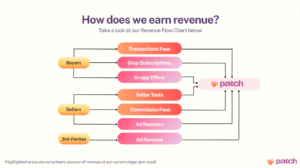
Figure 19. Description.
As part of our risk mitigation and planning, we considered 3 cases in doing our projections, an optimistic, mid-point, and pessimistic case. The values are benchmarked from user acquisition, transacting users, and monetization efficiency. In all cases, we will have a positive net profit at Y3 but the optimistic case is the ideal case where as early as year 2, we are already profiting. Detailed computations can be accessed through this sheet (see our Financial Projection sheet in CONFIDENTIAL INFO for reference). This file was also shared to our investors and are currently reviewing it.
As part of our commitment to deliver a robust financial health in Patch, we set up a consultation with a lawyer who works as a corporate secretary at a Philippine company. We were able to consult matters regarding labor and expenses. We want to deliver the best app while ensuring it to be cost efficient also.

The team also opened a bank account in preparation for monitoring our finance and transactions as we are expecting to operate soon. We currently have a separate account for Patch at a commercial bank.
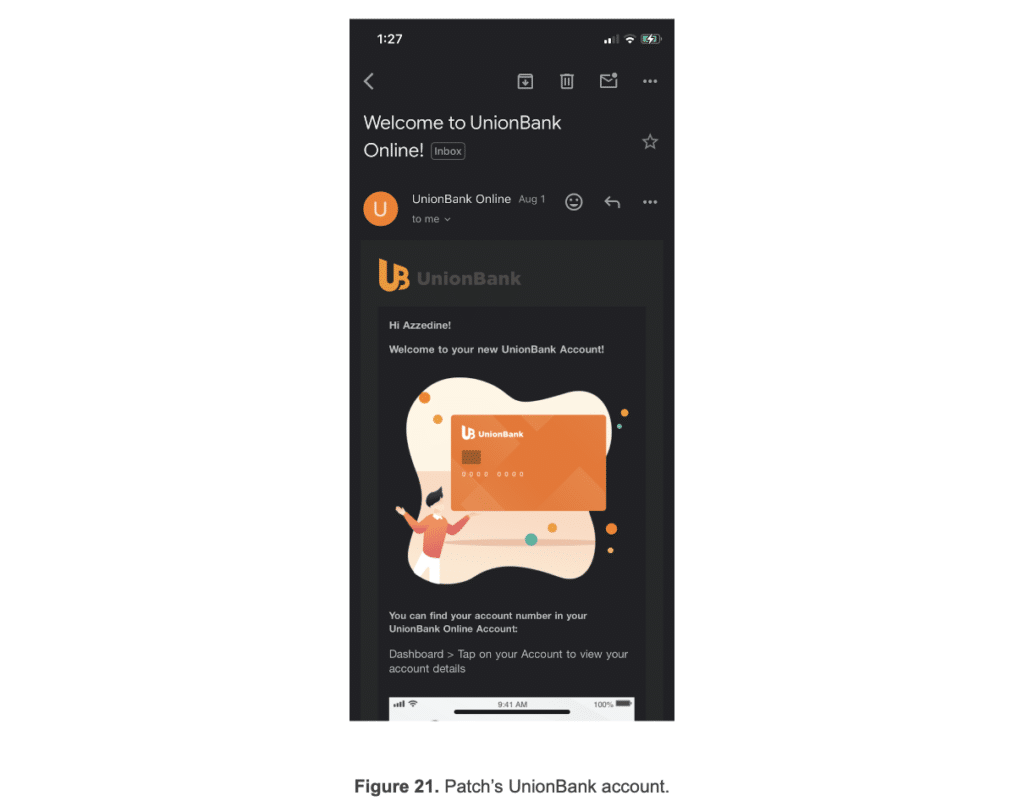
B3. Team and leadership
As of writing, our team is limited to our founders and our Board of Advisors. We are a team of four women leaders and problem solvers coming from different backgrounds.
- Gab Dotado, our Chief Executive Office, is a student at Ateneo de Manila University (ADMU) studying Legal Management and International Business. She secured US securities licensing for Invesko and led a tech adoption project at Shopee, SEA’s #1 e-commerce.
- Azzy Abrencillo, our Chief Financial Officer, recently graduated from her Bachelor’s degree in Applied Mathematics and now studies in UP Diliman pursuing Masters of Arts in Economics. She drove finance and digital initiatives for Humble Sustainability and the legislative office of Senator Kiko Pangilinan.
- Lenz Dagohoy, our Chief Operating Officer, studies Anthropology and Computer Science at ADMU. They also co-founded an AI safety nonprofit called Condor Global Southeast Asia (SEA) which has traction in 8 SEA countries, and helped 4 startups raise a total sum of USD 15.5k during their time working at ADMU’s startup incubator. They are also currently studying patent drafting as a scholar of the World Intellectual Property Organization (WIPO).
- Angelica Casuela, our Chief Techonology Officer and interim Chief Marketing Officer, is a Software Engineer at Enstack while pursuing a Masters in Technology Management at the University of the Philippines. She has also engaged in brand development and building social media presence at Saliksik.
While they are pursuing their own fields and expertise, their passion for technology and fashion lets them build a team that works and learns together. We visit thrift stores and explore fashion together and like to eat in between. This is one way our team bonds while ensuring our time together is meaningful.
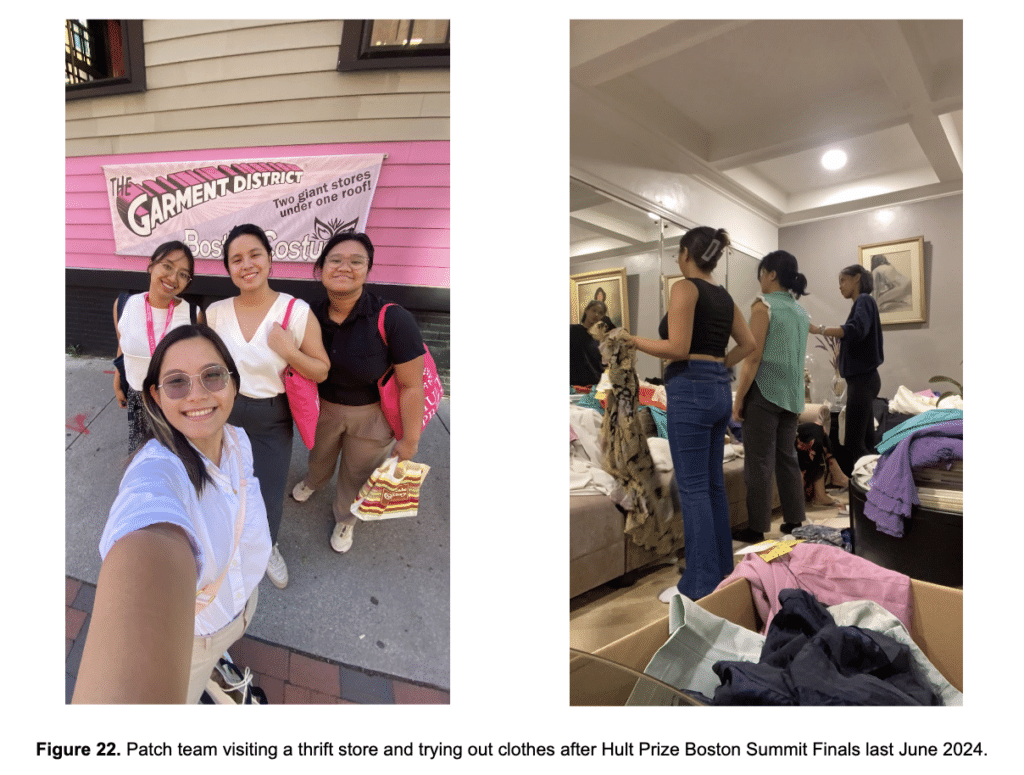
We have also been building our Board of Advisors to strengthen our enterprise’s human capital.
- Erwin Lizarondo is an expert in social enterprise design. He’s a lecturer in 2 of Philippines’ top business schools, Thames International and Asian Institute of Management.
- Atty. Rhett Gaerlan is our advisor on regulatory compliance and a practicing lawyer specializing in labor relations. He recently agreed to be our Philippine legal entity’s Corporate Secretary.
- Constancy Casuela-Salalima is our advisor on finance and fundraising. She currently serves as an executive at a leading bank in Germany.
- Jay Bautista is our advisor in media and advertising. He is the Philippine director of Kantar, a UK-based media firm.
- Yedukrishnan Pushpendran is our advisor in operations and logistics. He has 5+ years of experience in e-commerce strategy, and is currently an MBA student at Stanford University.
We are still looking for an advisor for product and engineering. Currently, we are in communication with Bani Balaguer, the CEO of a software consultancy called Cynder, to consult about our technical infrastructure.

In the next few weeks, we are looking into recruiting 2 to 4 apprentices from the University of San Francisco to help us expand our capacities for user research in exchange for college credit.
B4. Partnership and collaboration
Our partnerships and collaboration continuously expand to foster and create a bigger community for the thrifting community. Patch was invited to discuss a possible collaboration with Echelon Philippines, a tech business conference. This is a great opportunity for the team to meet with investors and entrepreneurs.

We plan to maximize our social capital by partnering with an animal welfare cause. This group was providing access through transportation to low cost spay and neuter. As much as they advocate for animal welfare they also advocate for responsible consumption to reduce risks for stray animals with the risks of improper waste management and its effect. They agreed to do a free promotion of Patch through including us in their brochure materials for one event.

Aside from collaborations and partnership, Patch continues to receive an express of interest in our business through the messages we receive over the past few weeks. These messages come from shops or businesses already and some come from individual casual sellers. The main communication channel they use is through sending a message in our Instagram account.

As mentioned earlier, we are also working on a partnership with the University of San Francisco to provide students of Social Entrepreneurship a credited 100-hour internship with Patch for the rest for the rest of the Fall semester.

C. ESG reporting
C1. Measurement and reporting

|
| Figure 28. ESG reporting framework by Patch |
C2. Compliance with ESG standards and frameworks
In the Philippines, sustainability reporting is a relatively new practice. Despite the global trend toward increased sustainability impact disclosure, publicly listed companies (PLCs) in the Philippines had low compliance rates when it came to publishing sustainability reports. A 2017 KPMG survey found that only 22% of the PLCs published sustainability reports, a stark contrast to 93% of the world’s largest 250 companies and 75% of the top 100 companies in 49 countries that report on sustainability.
The SEC has announced that starting from 2023, sustainability reporting will become mandatory for all publicly listed companies (PLCs) in the Philippines. This means that in addition to their annual reports, these companies will also need to submit their sustainability reports to the SEC.
This decision marks a significant step forward in the country’s approach to corporate sustainability, aligning the Philippines with other countries where sustainability reporting is already mandatory, such as Thailand, Singapore, Malaysia, and Indonesia. This mandatory approach to sustainability reporting is expected to further enhance the transparency and accountability of PLCs in the Philippines.
A key feature of the SEC’s approach to sustainability reporting is the “comply or explain” principle. This principle gives PLCs enough time to determine what is considered significant and collect data (if they are going to determine the material impact) or provide explanations (if they do not have data).
Moving forward, we can partner with Keslio.

|
| Figure 29. Plan for ESG reporting for Patch |
D. Learning curve

|
| Figure 30. Key lessons in Patch. |




